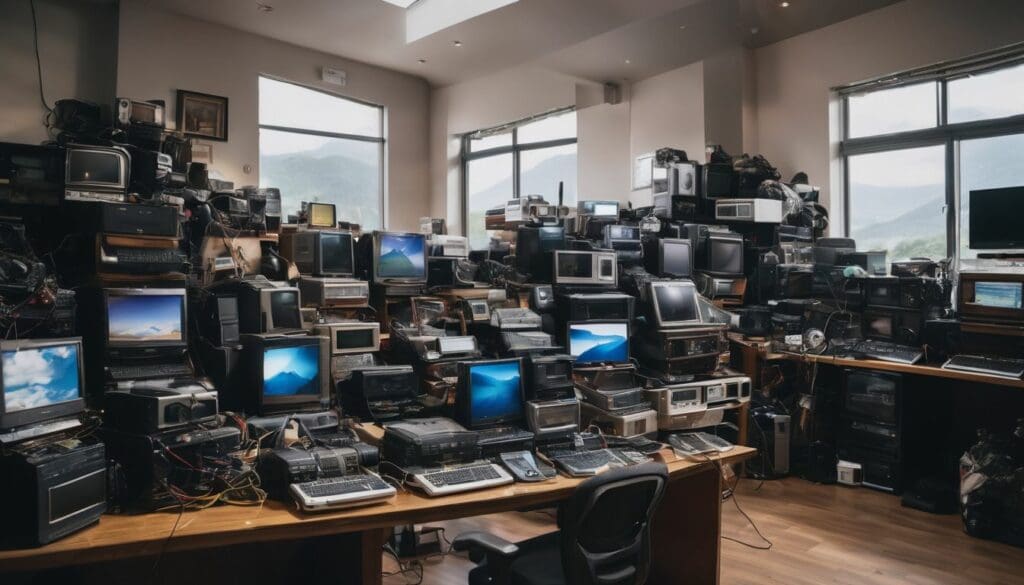Are you watching old gadgets pile up in drawers and wondering how to dispose of them responsibly? Every year, the world generates around 50 million tonnes of electronic waste. Our guide will take you through the steps to create a successful community e-waste recycling event that benefits both the environment and your neighbourhood.
Let’s make a difference together!
Key Takeaways
- To tackle the mounting problem of e-waste, create a community recycling drive by first partnering with a certified recycler who follows ethical and environmental standards like R2 or e-Stewards certifications.
- Spread the message about your e – waste initiative through an engaging campaign involving local businesses, schools, and media agencies to educate the public on the importance of responsible disposal practices.
- Choose a convenient location for your event that is accessible to all community members and pick a date that avoids conflicts with other events, allowing enough time to promote awareness effectively.
- Build an enthusiastic team of volunteers by reaching out across social networks and local organisations; provide educational opportunities at the event such as workshops on upcycling electronic devices.
- By promoting circular economy principles through responsible electronics disposal, we contribute towards reducing raw material demand, conserving resources and fostering innovation in eco-friendly technology practices.
Understanding the Impact of E-Waste
E-waste is a growing problem worldwide, posing hazardous effects on health and the environment. It’s crucial to understand the impact of e-waste in order to take action towards proper recycling and disposal.
Growing problem worldwide
Electronic waste is mounting at an alarming rate globally, with millions of gadgets discarded each year. This surge in outdated and broken devices comes from rapid technological advances that make electronics obsolete faster than ever before.
Our hunger for new gadgets leaves behind a vast trail of electronic refuse, posing severe risks to the environment.
Countries are grappling with how to handle this influx of e-waste. Many lack proper recycling facilities, which means harmful materials can leach into the soil and waterways. This creates urgent pressure for communities everywhere to adopt sustainable ewaste management practices and foster environmental conservation through initiatives like certified ewaste recyclers and community recycling drives.
Hazardous to health and the environment
E-waste, such as old laptops and mobile phones, contains toxic chemicals like lead, mercury, and cadmium. When improperly disposed of in landfills, these hazardous substances can leach into the soil and water supply, posing serious health risks to people and the environment.
Burning e-waste releases harmful pollutants into the air, contributing to air pollution and respiratory issues.
Toxic materials found in electronic waste also have a detrimental impact on wildlife when it contaminates ecosystems through improper disposal methods. Wildlife may ingest or come into contact with these toxins which can lead to long-term health problems or death.
The Importance of Recycling E-Waste
Recycling e-waste is essential in reducing our carbon footprint and keeping hazardous toxins out of landfills. It plays a crucial role in promoting sustainable living and eco-friendly practices.
Reducing carbon footprint
To reduce carbon footprint, consider recycling old electronic devices instead of disposing of them in landfills. This practice prevents toxic substances from contaminating the environment while conserving energy and reducing greenhouse gas emissions.
By participating in e-waste recycling drives, individuals can contribute to sustainable living and help minimise the negative impact of electronic waste on the environment.
Implementing eco-friendly practices like responsible electronics disposal fosters resource conservation and promotes a circular economy. Supporting community electronic waste recycling initiatives helps to reduce environmental pollution and encourages greener technology adoption for a healthier planet.
Keeping toxins out of landfill
Recycling e-waste prevents harmful chemicals from seeping into the ground, protecting our environment. Toxic substances like lead and mercury can leak from electronic devices in landfills, contaminating soil and water sources nearby.
By recycling old electronics through certified recyclers, we can ensure that these toxins are safely disposed of or recovered for reuse, contributing to a healthier planet and community.
E-waste recycling keeps hazardous materials out of landfills where they pose a threat to public health and the environment. It’s essential to engage in responsible disposal of electronic waste by working with certified recyclers who can handle these materials properly.
How to Organise an E-Waste Recycling Drive
To organise an e-waste recycling drive, start by identifying a certified recycler and securing a location and date for the event. Build a team and promote the event to gather as much electronic waste from the community as possible.
Identify a certified recycler
To ensure the responsible disposal of e-waste, seek out a certified recycler. Look for certifications such as R2 or e-Stewards, which guarantee ethical and environmentally friendly handling of electronic waste.
By choosing a certified recycler, you can be confident that your community’s e-waste will be managed in an eco-friendly and sustainable manner while adhering to strict industry standards.
When selecting a certified recycler, consider their track record and reputation in the industry. Verify their compliance with environmental regulations and inquire about their recycling processes to ascertain they align with sustainable practices.
Secure a location and date
Find a convenient and accessible location for the e-waste recycling drive. Make sure the venue is large enough to accommodate the expected turnout of participants and easily accessible for people dropping off their electronic waste.
Once you have decided on the location, set a date that allows ample time for planning and promotion, ensuring it doesn’t clash with other community events or holidays.
Engage with local authorities to obtain any necessary permissions or permits for hosting the event at your chosen location. Promote the event across various platforms within your community, such as social media, community notice boards, and local newsletters.
Build a team and promote the event
Recruiting a dedicated team is crucial for the success of an e-waste recycling drive. Identify passionate individuals who can help plan and execute the event, from securing a location to spreading awareness.
Engage local volunteers through social media, posters, and community events to raise interest in the initiative. Collaborate with environmental organisations and local businesses to leverage their networks and resources in promoting the e-waste collection event.
Furthermore, consider hosting informational sessions on electronic waste management to educate the public about the importance of responsible disposal practices. Encourage participants to spread the word within their social circles, amplifying the impact of your outreach efforts across various demographics.
Ways to Involve the Community in E-Waste Recycling
Spread awareness and start a campaign to educate the community about the impact of e-waste. Partner with local businesses and media agencies to amplify your message and reach a wider audience.
Host a funfair or carnival as an engaging way to encourage participation in e-waste recycling efforts.
Spread awareness and start a campaign
To increase awareness about e-waste recycling, create an engaging campaign. Utilise social media, posters and flyers to inform the community about the event and the importance of responsible e-waste disposal.
Collaborate with local influencers or eco-conscious organisations to amplify your message further.
Engage schools, businesses and community groups by educating them on the impact of e-waste on our environment. Encourage them to join in your efforts and spread the word among their networks.
Partner with local businesses and media agencies
Collaborate with local businesses and media agencies to broaden your reach and impact. By partnering with community businesses, you can create drop-off points for e-waste collection and raise awareness through their customer base.
Media agencies can help publicise your event, reaching a wider audience and encouraging more people to participate in the e-waste recycling drive.
Engaging local businesses will not only increase participation but also demonstrate a collective effort to address e-waste issues. Collaborating with media outlets will amplify your message, educating the public about the importance of responsible electronics disposal.
Host a funfair or carnival
Arrange a community funfair or carnival to coincide with the e-waste recycling drive, featuring games and activities for all ages. Set up educational booths where participants can learn about the impact of e-waste on the environment and how proper disposal can help mitigate this issue.
Collaborate with local businesses to provide prizes or sponsorships as incentives for attendees to bring in their old electronics for recycling.
During the event, encourage hands-on participation by offering workshops on upcycling electronic devices into new useful items, showcasing innovative projects that repurpose e-waste creatively.
Tips for a Successful E-Waste Collection Event
Ensure proper planning and preparation to host a successful e-waste collection event that promotes responsible electronics disposal and supports the circular economy.
Ready to learn more about organising a community e-waste recycling drive? Keep reading to discover how you can make a positive impact on the environment!
Proper planning and preparation
When organising a community e-waste recycling drive, proper planning and preparation are essential for a successful event. Begin by creating a detailed timeline and checklist to track tasks and deadlines.
Secure necessary permits, permissions, and logistical support well in advance to ensure smooth execution of the event.
Identify potential risks or challenges that may arise during the e-waste collection event and develop contingency plans to address them effectively. Additionally, consider partnering with local businesses or organisations to provide resources such as volunteers, transportation, or promotional support.
Partnering with a handler or recycler
Partner with a certified e-waste handler or recycler to ensure proper disposal. Engage in discussions about their recycling process and certifications to validate responsible electronic waste management practices.
Establish a partnership for the collection event, guaranteeing the safe handling and environmentally friendly disposal of all items.
Take initiative by reaching out to local recyclers who share your commitment to sustainable electronics disposal. This proactive approach can foster strong relationships and pave the way for future collaboration on community-led environmental initiatives.
Promoting circular economy through responsible electronics disposal
Responsible electronics disposal promotes a circular economy by reducing the need for raw materials. Recycling e-waste conserves resources, lessening the demand for new products and minimising environmental impact.
It also encourages innovation in eco-friendly practices.
Promoting circular economy through responsible electronics disposal is crucial to our collective effort towards sustainable living. By engaging in eco-friendly practices such as recycling e-waste, we actively contribute to waste reduction and green technology adoption.
Conclusion
In conclusion, organising a community e-waste recycling drive can make a significant impact on reducing electronic waste. It involves raising awareness and engaging the public in responsible electronics disposal.
By partnering with local businesses and media agencies, we can encourage eco-friendly practices and contribute to a healthier environment. Ultimately, through collective efforts, we can work towards a sustainable future for generations to come.
FAQs
1. What is a community e-waste recycling drive?
A community e-waste recycling drive is an event where people can bring their unwanted electronic items to a specific location for eco-friendly disposal and recycling.
2. How do you organise an e-waste collection event?
To organise an e-waste collection, choose a recycling location, spread public awareness about the event, and arrange for the safe handling and disposal of the collected waste.
3. Why should I be involved in hosting an e-waste collection drive?
Hosting an ewaste collection helps protect the environment by ensuring electronics are recycled properly and raises electronics recycling awareness in your community.
4. What kind of items are collected at an ewaste event?
An ewaste event will collect items like old phones, computers, TVs, and batteries that require special handling during disposal to prevent harm to the environment.
5. How can I get my neighbours involved in our local ewaste recycling effort?
You can boost public involvement in ewaste recycling by reaching out through community outreach initiatives such as flyers, social media posts or local meetings to educate others on ecofriendly practices.





